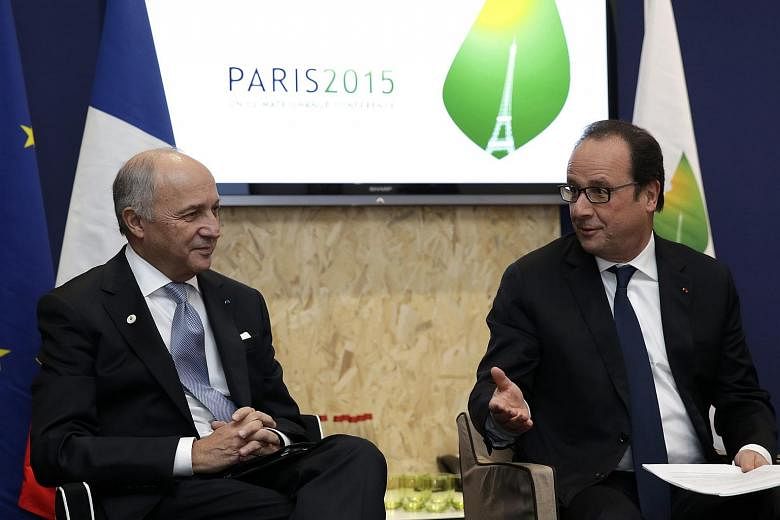PARIS • The mammoth task facing delegates at the COP21 climate summit in Paris can be measured by wading through the negotiating text that contains hundreds of instances of square-bracketed words, phrases, terms and even whole paragraphs.
Each square bracket denotes an area of contention, even a flashpoint, more often than not between the developed world and countries that are still developing, with much of the disputation over their "common but differentiated responsibilities" in tackling climate change.
All of these differences must be ironed out in the negotiations that the COP21 president, French Foreign Minister Laurent Fabius, is determined to conclude on Friday with a comprehensive agreement.
The text produced in advance of the summit acknowledges that climate change represents an urgent and potentially irreversible threat and calls for an effective and appropriate international response, with a view to accelerating the reduction of global greenhouse gas emissions, recognising that deep cuts will be required. One option says rich nations should make deeper cuts, while reductions for developing nations will take longer.
-
Unresolved issues
-
Within the plentiful square brackets are issues yet to be decided upon by the climate negotiators in Paris.
ARTICLE 2: PURPOSE
1. The purpose of this Agreement is [to enhance the implementation of the Convention] [AND] [to achieve the objective of the Convention as stated in its Article 2]. In order to strengthen the global response to the threat of climate change, Parties agree to take urgent action and enhance cooperation and support so as:
(a) To hold the increase in the global average temperature [BELOW 1.5°C] [OR] [well below 2°C] above preindustrial levels by ensuring deep reductions in global greenhouse gas [NET] emissions
ARTICLE 3: MITIGATION
Parties [COLLECTIVELY] [COOPERATIVELY] aim to reach the global temperature goal referred to in Article 2 through:
(a) [A peaking of global greenhouse gas emissions as soon as possible[, recognising that peaking requires deeper cuts of emissions of developed countries and will be longer for developing countries]]
(b) [Rapid reductions thereafter [in accordance with best available science] to at least a X [-Y] per cent reduction in global [greenhouse gas emissions] [CO2[E]] compared to 20XX levels by 2050]]
COURTESY OF THE IRISH TIMES, A MEMBER OF THE CLIMATE PUBLISHERS NETWORK
But there is no consensus on the extent of these cuts or on a timetable for implementing them. Nor is there any agreement on capping the rise in average global surface temperatures at a particular level.
There is also a wide gulf over how to achieve any of these temperature goals. Options talk of peaking global greenhouse gas emissions as soon as possible and aiming for a low-carbon transformation over the course of this century or as soon as possible after mid-century.
Also in brackets is a statement noting that the largest share of historical global emissions has originated in developed countries, while per-capita emissions in developing countries are still relatively low and that the share of their global emissions will grow to meet their social and development needs.
Given that pledges made by 180 countries to take action on climate change will still leave a wide "emissions gap" of 12 billion tonnes of carbon dioxide in 2030, one of the critical issues to be thrashed out in the negotiations is how these can be racheted up over time.
Agreement has yet to be reached over how this "global stocktaking" is to be done and when it might kick in, although "every five years" is mentioned - but in brackets. So is a reference to developing countries requiring aid from their richer counterparts to take further actions.
COURTESY OF THE IRISH TIMES, A MEMBER OF THE CLIMATE PUBLISHERS NETWORK

